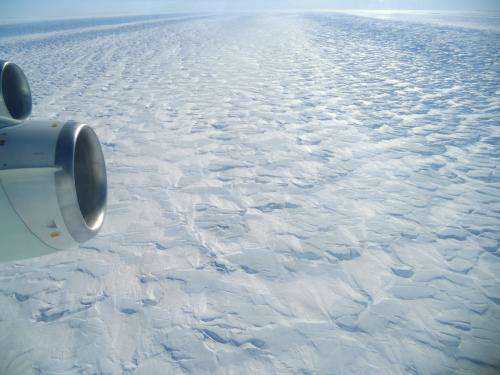Huge iceberg breaks away from the Pine Island glacier in the Antarctic

On 8 July 2013 a huge area of the ice shelf broke away from the Pine Island glacier, the longest and fastest flowing glacier in the Antarctic, and is now floating in the Amundsen Sea in the form of a very large iceberg. Scientists of the Alfred Wegener Institute - Helmholtz Centre for Polar and Marine Research have been following this natural spectacle via the earth observation satellites TerraSAR-X from the German Space Agency (DLR) and have documented it in many individual images. The data is intended to help solve the physical puzzle of this "calving".
Scientists from the American space agency NASA discovered the first crack in the glacier tongue on 14 October 2011 when flying over the area. At that time it was some 24 kilometres long and 50 metres wide. "As a result of these cracks, one giant iceberg broke away from the glacier tongue. It measures 720 square kilometres and is therefore almost as large as the city of Hamburg", reports Professor Dr Angelika Humbert, ice researcher at the Alfred Wegener Institute.
The glaciologist and her team used the high resolution radar images of the DLR earth observation satellite TerraSAR-X to observe the progress of the two cracks and to better understand the physical processes behind the glacier movements. The researchers were thus able to measure the widths of the gaps and calculate the flow speed of the ice. "Above the large crack, the glacier last flowed at a speed of twelve metres per day", reports Humbert's colleague Dr Dana Floricioiu from DLR. And Nina Wilkens, PhD graduate in Professor Humbert's team, adds: "Using the images we have been able to follow how the larger crack on the Pine Island glacier extended initially to a length of 28 kilometres. Shortly before the "birth" of the iceberg, the gap then widened bit by bit so that it measured around 540 metres at its widest point."

The scientists incorporate these and other TerraSAR-X satellite data in computer simulations using which they are able to model the break and flow mechanisms of the ice masses. "Glaciers are constantly in motion. They have their very own flow dynamics. Their ice is exposed to permanent tensions and the calving of icebergs is still largely unresearched ", explains ice modeller Angelika Humbert.
The scientist and her team then compare their simulation results with current satellite data such as from TerraSAR-X. If the model agrees with reality, the scientists can conclude, for example, the gliding property of the ground beneath the glacier ice and how the ice flow could behave in the event of further global warming.
Are ice breaks caused by climate change? Angelika Humbert does not so far see any direct connection: "The creation of cracks in the shelf ice and the development of new icebergs are natural processes", says the glaciologist. However, the Pine Island glacier, which flows from the Hudson mountains to the Amundsen Sea, was the fastest flowing glacier in the Western Antarctic with a flow speed of around 4 kilometres per year. This speed is less caused by the rising air temperatures, however, and is more attributable to the fact that the wind directions in the Amundsen Sea have altered. "The wind now brings warm sea water beneath the shelf ice. Over time, this process means that the shelf ice melts from below, primarily at the so-called grounding line, the critical transition to the land ice", says the scientist.
For the Western Antarctic ice shelf, an even faster flow of the Pine Island glacier would presumably have serious consequences. "The Western Antarctic land ice is on land which is deeper than sea level. Its "bed" tends towards the land. The danger therefore exists that these large ice masses will become unstable and will start to slide", says Angelika Humbert. If the entire West Antarctic ice shield were to flow into the Ocean, this would lead to a global rise in sea level of around 3.3 metres.

Shelf ice
The shelf ice, which is 200 to 1200 metres, thick is created by glaciers sliding into the sea. It is therefore an extension of the Antarctic land ice which thins at the edges and floats on the sea. The ice shelf itself rests on the Antarctic continent, reaching a thickness of up to four kilometres and is largely frozen to the rock bottom. A special feature of the Western Antarctic is that large areas of land are below sea level.
Provided by Helmholtz Association of German Research Centres



















